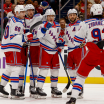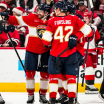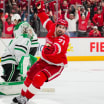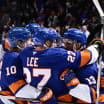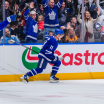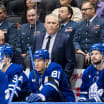Mailbag: Blue Jackets' needs, rise of analytics in hockey
NHL.com's Dan Rosen answers weekly questions
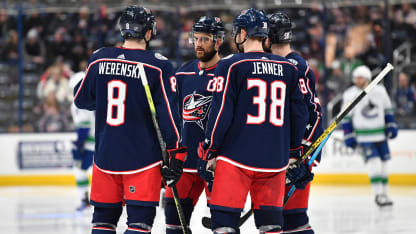
© Jamie Sabau/Getty Images
For us Columbus Blue Jackets fans, give us your opinion on what you think needs to happen to turn us from the team nobody wants to face in the first round to the team that people believe can actually make a run for the Stanley Cup? Who and how can we improve to get to that point? -- @DeGoodPoint
The Blue Jackets need to score more, especially on the power play. They work hard and defend well but have little room for error because of their struggles to score. A big part is controlling the puck, which has been a problem for them in the Stanley Cup Playoffs. Their 46.0 shot attempts percentage in the playoffs the past three seasons is 17th among the 18 teams that have played at least 15 postseason games (2020 Stanley Cup Qualifiers included). They are seventh among the 18 teams in average power-play time per game in the playoffs the past three seasons (5:53), but within that group, they're 15th in power-play percentage (16.9 percent). In a six-game loss to the Boston Bruins in the 2019 Eastern Conference Second Round, Columbus lost 3-2 in overtime in Game 1 of the best-of-7 series, when it was 0-for-4 on the man-advantage, and 4-3 in Game 5, when it went 0-for-2. An extra power-play goal or two and the Blue Jackets are maybe closer to making a run for the Stanley Cup. You're right that they're a team nobody wants to face in the first round, but poor puck possession and power-play production have held them back. They need to improve in those areas.
31 in 31: Columbus Blue Jackets 2020-21 preview
After the NHL announces the official start do you think we will see a flurry of signings/deals, or do you think there will be more PTOs with hard offers given closer to the actual start of the season? -- @mikeybox
An official start date for the 2020-21 NHL season has not yet been announced. Once it is, I expect more PTOs (professional tryouts) than official signings before training camp because so many teams are at or near the NHL salary cap ($81.5 million), making it hard to commit to another contract right away. Once camp begins, players on PTOs will be given a chance to make teams with the potential that injuries, opt-outs or other possibilities could create salary cap space. We will see players who we never thought would be on a PTO going into training camp this season on a PTO because they didn't get signed in the initial wave of free agency, and now it would be easier on teams to invite them to camp with no strings attached.
That said, I expect some players to sign contracts before camps open, most notably defenseman
Zdeno Chara
and forward
Mike Hoffman
. I'll be stunned if Chara doesn't eventually agree to a one-year contract with the Boston Bruins. The Blue Jackets, New Jersey Devils, Nashville Predators and Los Angeles Kings all have the salary cap space and all would benefit from signing Hoffman. They all need more offense, and Hoffman is averaging 0.90 goals per 60 minutes since 2014-15, tied for 26th with Matt Duchene (Predators) and Jamie Benn (Dallas Stars) among the 208 players who have played at least 400 NHL games in that span. He's scored 169 goals in 464 games since 2014-15, including 65 goals in 151 games the past two seasons.
With the advent of meticulous analytics within sports and specifically the NHL, what changes could this data bring? Could we see more of a "moneyball" approach to drafting, developing, trading and signing players? Do you believe in Corsi, etc.? -- @theashcity
It's happening now. For example, I think the understanding of what are typically referred to as advanced stats is a factor for why the enforcer has been all but eliminated from the NHL. The game is too fast to have skaters who can't keep up. To win now, you need to have three lines that can score and a fourth that can grind, keep the puck and be a threat to score.
Keeping the puck is the key. Puck possession is the most popular analytics metric that has been in the NHL. It makes perfect sense. When you have it, you have a chance to score. When you don't, you're vulnerable. But there are many more statistics that help the scouting and evaluation process. I used to laugh at the expected goals statistic, wondering how can we reasonably expect a goal? But the statistic is based on shot location and type. It's obvious that your chances of scoring increase if you're closer to the net, and they are even greater if the shot is coming off a rebound, when the defense isn't set and the goalie is moving. Individual expected goals percentage is a meaningful statistic because it measures the types and location of shots a team is taking when the player is on the ice. We also see more teams using a 1-3-1 setup on the power play. They do so because the players are more spread out inside the zone, there is still a net-front presence, and it's proven harder to defend.
By now, every NHL team is using a model of analytics, most of which are proprietary. All teams have analysts or entire analytics departments working within the hockey operations department. Coaches are getting more information now than they ever have before, and it's up to them to decipher what is meaningful and how it can be used in prescouts and during games.
The "moneyball" approach is necessary in the NHL because of the salary cap. It's about getting greater value per dollar spent, whether that's through development, signings or trades. The statistics help to measure the value, and finding value players to play on the third and fourth lines and on the second and third defense pairs ultimately leads to success.
What can you see the New York Islanders doing before the season starts up? Mathew Barzal is priority No. 1, but they'll look different, no doubt. What do you see them doing with any remaining cap space? -- @johnfiorino97
Don't be disappointed if the Islanders look and feel much the same as they did last season. That wouldn't be a bad thing since they reached the Eastern Conference Final. Barzal is priority No. 1, and he'll eat away at a major chunk of the cap space they have remaining. My expectation is that forward
Matt Martin
and defenseman
Andy Greene
will be brought back, each on a one-year contract. Forward
Derick Brassard
could be too, if only to give a little more time to forward prospects
Oliver Wahlstrom
and
Kieffer Bellows
.
I look at the Islanders as having 11 locks at forward (Barzal, Anders Lee, Brock Nelson, Jordan Eberle, Josh Bailey, Jean-Gabriel Pageau, Cal Clutterbuck, Casey Cizikas, Anthony Beauvillier, Leo Komarov and Ross Johnston) and five at defenseman (Nick Leddy, Ryan Pulock, Adam Pelech, Scott Mayfield and Noah Dobson). That leaves
Dmytro Timashov
, Michael Dal Colle, Wahlstrom, Bellows, Andrew Ladd, Austin Czarnik,
Joshua Ho-Sang
and possibly Martin and Brassard competing for the final few spots at forward. They're thinner at defenseman, but Sebastian Aho, Thomas Hickey and possibly Greene could fill out the depth chart. If there is room to add, the Islanders should focus on a defenseman, especially because they don't have Devon Toews (traded to the Colorado Avalanche) or Johnny Boychuk (retired) anymore.
What do you think of the New York Rangers' offseason? Anything you wanted to see that didn't happen? Where do you see them finishing this season? Does the shortened season have an impact on them being a young team with Alexis Lafreniere coming as well? -- @Solomon75334328
Their offseason was fine. Nothing special. Nothing out of the ordinary. Nothing necessarily missing. The catch was Lafreniere with the No. 1 pick in the 2020 NHL Draft. It wasn't surprising they bought out the final year of goalie Henrik Lundqvist's contract. That was a foregone conclusion, unless Lundqvist decided to retire, and that wasn't going to happen. Lafreniere should be a top-nine forward with the potential for much more in the near future. They'll take a hit in the character and intangibles departments because they traded defenseman Marc Staal to the Detroit Red Wings and didn't re-sign forward Jesper Fast, who went to the Carolina Hurricanes. But the Rangers have their core in place, including true No. 1 center Mika Zibanejad, elite playmaking wing Artemi Panarin and strong goaltending with Igor Shesterkin and Alexandar Georgiev.
The Rangers should be in the mix for the playoffs regardless of the division alignment or playoff format. The shortened season shouldn't affect them if they play the way they played in the last six weeks of last season, when they were 14-7-1 (.659 points percentage), averaged 3.41 goals per game and 2.86 goals-against per game, and went 26.2 percent on the power play from Jan. 31-March 11. They pushed the offense without sacrificing on the defensive end. That's their blueprint. The key will be a strong start because the shortened season means they have less time to recover.








